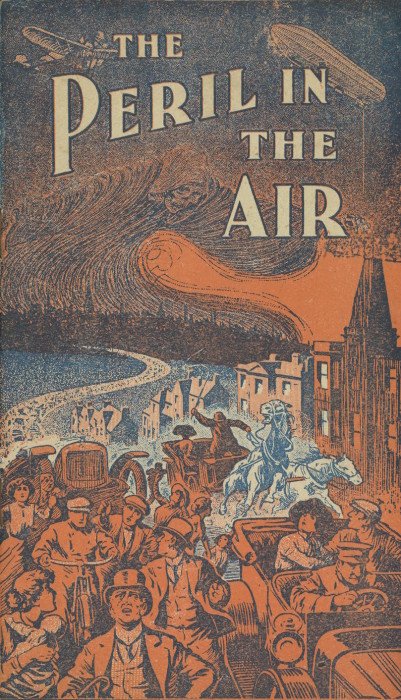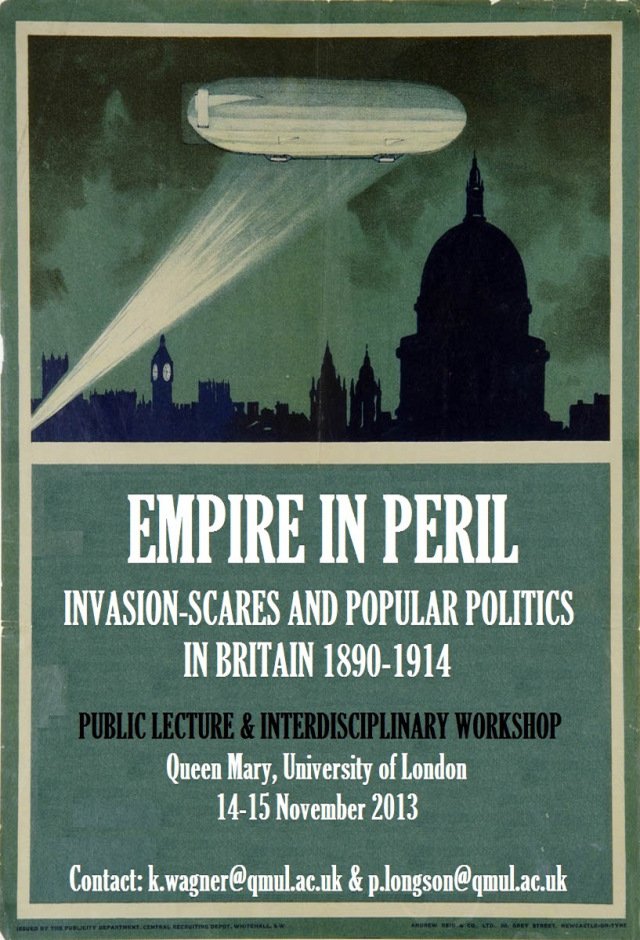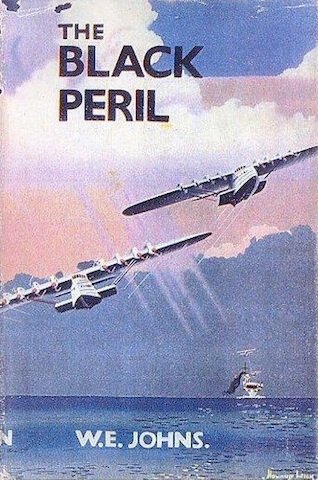This could be the lurid cover of an Edwardian novel about the dangers of aerial bombardment, with an aeroplane, an airship and Death himself hovering over a great city, watching the terrified populace streaming outwards in panic: the first knock-out blow from the air. But it’s not. Instead it’s the lurid cover of an Edwardian advertising brochure for Peps tablets, claimed to alleviate everything from coughs and colds to potter’s rot and pulmonary tuberculosis, any ailment of the throat and chest.
Nothing to do with aviation, then. So how to explain this image? The first page explains:
Did the picture on the front cover startle you? It is not intended as a warning against the invasion of Britain by foreign air-ships [sic]. It has a more personal interest.
It is designed to emphasise the ever-present and more deadly germ peril that is a daily menace to every man, woman, and child in the country, and is really the cause of our throat and chest troubles. Any doctor will tell you that even the common cold — the beginning of bronchitis and serious lung trouble — is caused by infectious germs that float about unseen in the air.1
So the eye-catching cover is intended to make you think it’s about the peril of the airship, to make you pick it up and start reading, at which point you find out it’s about the even more deadly peril of the air germ, against which you can, fortunately, protect yourself by buying a box of Peps tablets at 1/1½ or 2/9. It’s an advertising trick.
But for the trick to work, the intended audience presumably would be highly aware of the other, lesser, but sadly better publicised peril in the air, the one involving aircraft. Which is, of course, where I come in. The Wellcome Library dates this pamphlet to June 1913, I suspect based on the ‘6/13’ next to the printer’s information on the inside back cover. That date certainly works for me, because it’s just after the end of the 1913 phantom airship panic, by which point the press had been filled with stories of Zeppelins violating British airspace at will for months. The Peps Co. wasn’t the only advertiser to try to capitalise on the airship panic; by the previous March the North British & Mercantile Insurance Company had similarly been telling newspaper readers that ‘The real peril’ was the lack of security against old age, burglary, accident, fire, and death, not Zeppelins.
There is perhaps something more than a trick here, though. You can see something like Peter Sloterdijk’s idea of ‘atmo-terrorism’ in play here two years before, in this conceptual linking of terror from the air with terror through the air.2 Indeed, Peril in the Air asserts that ‘A bad smoky fog causes more deaths than a modern battle’.3 In fact, ‘In London last Autumn fog increased the death-rate 40 per cent. in three weeks, but even in normal times the atmosphere of London is so heavily charged with soot and disease germs that instead of being pink in colour, the lungs of the average Londoner are either a thunder-cloud blue or coal black, from the dirt absorbed in breathing‘.4 The very air itself can no longer be trusted; the environment can no longer be taken for granted. Just as the best counter to an airship was another airship, Peps pills used (or claimed to use) the air itself to counter ‘the foul or foggy, germ-laden air as it is breathed in’, by being placed on the tongue and evaporating, and allowing it to ‘pursue and destroy the germs that have got into the air-passages’.5 Sloterdijk rather absurdly dates the start of the 20th century and its growing obsession with terror and environment to 22 April 1915, at Ypres, but the conceptual linkage was already there by 1913, and for that matter by 1880, when the city was already doomed by the air around it.
![]() This work is licensed under a Creative Commons Attribution-NonCommercial-NoDerivatives 4.0 International License.
Permissions beyond the scope of this license may be available at http://airminded.org/copyright/.
This work is licensed under a Creative Commons Attribution-NonCommercial-NoDerivatives 4.0 International License.
Permissions beyond the scope of this license may be available at http://airminded.org/copyright/.




